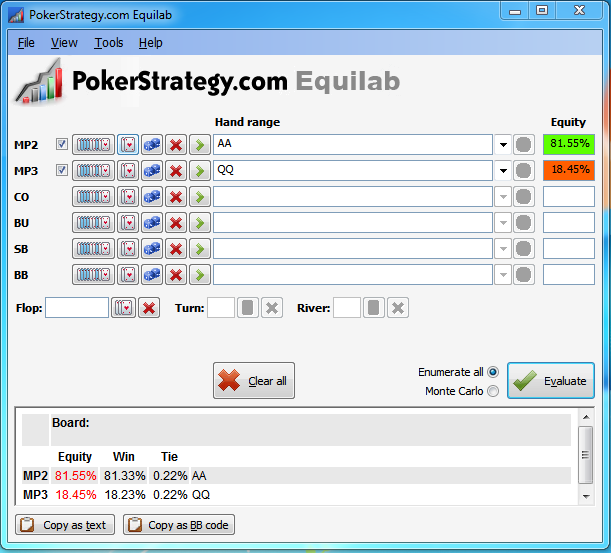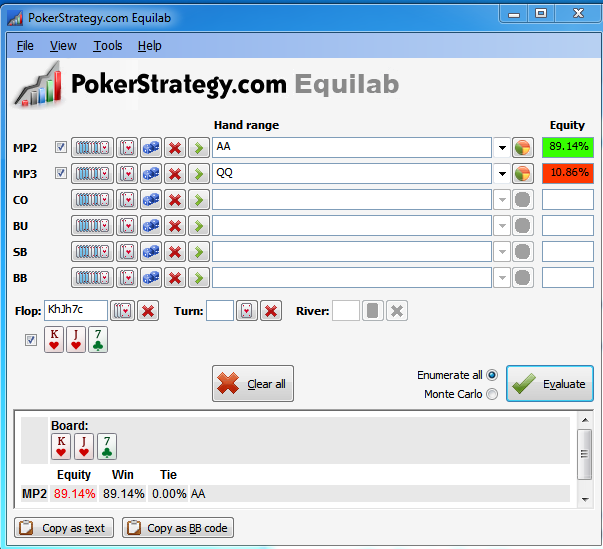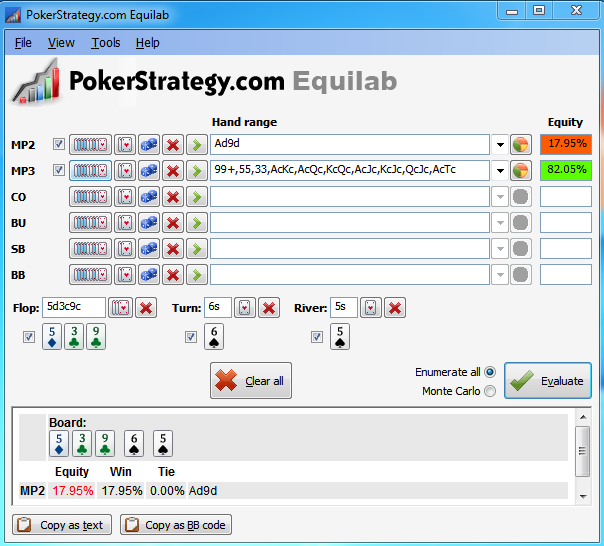Pot Equity is defined as our percentage chance of winning the pot when in a hand. We can define our equity from preflop all the way until the river and once we know what our opponents has in his hand (oftentimes we have to estimate what he may have). We can define equity against either a single hand or against a range of hands which our opponent could possibly hold.
Pot Equity in Practice
For calculating our equity we need to use a piece of software such as equilab. There is lots of other software out there that can do the same job; but equilab is free and easy to use.

Pot equity – AA v QQ preflop
If we want to see how AA performs vs QQ we can just plug it into equilab:
81% of the time AA will win and 18% of the time QQ will lose which means that AA is a heavy favorite in this spot but will still lose a small percentage.
We can then compared that on a random flop and turn and see how the equity changes:
ON a KhJh7c board QQ has almost 11% equity vs AA meaning that AA is an ever stronger favorite now:

Pot equity – AA v QQ on the flop
On the turn of Ts the equity increases to almost 14% due to the straight draw possibility. A 9 or an Ace will give QQ a straight meaning it has 6 outs to make the best hand.

Pot equity – AA v QQ on the turn
We cannot compute equity vs a single hand on the river as since there is no more cards to come. Thus hand values will not change further. However, it is possible to calculate equity vs a range of hands. For example we may think our opponent could have AA, AK and some bluffs such as A9 which we can calculate our equity against.
Pot equity with a real example
To take an example let’s look at the hand shown previously:
In this situation we expect villain to have some hands such as AA,KK,QQ, JJ and possibly TT. We believe he will play the hand by betting the flop turn and river. He will also have 33,55 and 99 although 99 being likely since we have a 9 in our hand. We also think villain will bluff some of the time; let's assume he bluffs with AK, AQ, AJ, AT, KQ, KJ and QJ all of clubs. If we sub this into equilab we find we have an equity of almost 18%:

Pot equity – A9s v range
Our equity of 18% isn't particularly good and if we call we will expect to lose the majority of the time. We will see in the next section that calling will be unprofitable.
Betting for Value
When you have the best hand in a game of poker you should be trying to build the pot to be as large as possible.
But what is meant by having the best hand?
It simply means that you have greater than 50% equity in the pot.
For example we had more than 50% equity in the AA example all through the hand. So that means we should have been value betting on all three streets in order to maximise the size of the pot and win the most chips.
However, it is not always possible to know exactly what your opponent is holding so you have to consider your opponents range and your equity vs that range.
Check out this video with recaps pot equity very well:
Conclusion
Equity realization is another important concept which is a measure of how much equity you will actually get to see. Here is a great article by PokerNerve on the subject to help you get a handle on it.
Follow up this lesson first with Expected Value (EV).

